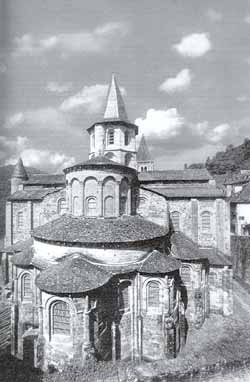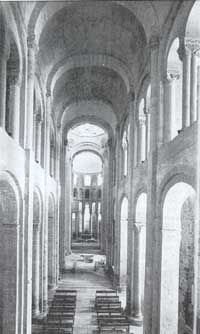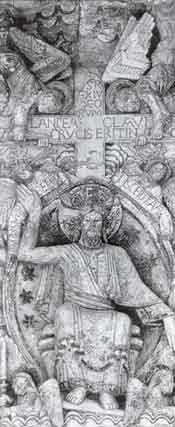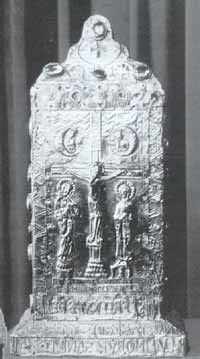St. Foy Abbey-Church
Marie-France Hilgar, Ph.D.
 |
Conques owes its origin to a hermit. After the initial efforts of Saint Martin of Tours and the first evangelists of Gaul, Christianity slowly began to penetrate the countryside. An initial religious building was perhaps constructed on the site later occupied by Conques as early as during the Merovingian era. At the center of an isolated though relatively densely populated region, it would have served to regroup the Christians of the surrounding area before its eventual destruction during a Muslim raid in the 7th century.
Later, the rare surviving texts mention a hermit by the name of Dadon, who was joined by another pious man around 819. Their holy reputation spread throughout the surrounding country and several others, attracted by the same contemplative life style, resolved to do likewise. The group increased in number, and a church was constructed, dedicated to our Holy Savior.
This was the age when the Carolingian sovereigns, for political as well as religious reasons, favored the monasteries of their empire and showed them much kindness. In fact, without such royal favors, the development of the Abbey at Conques might have been hampered, or even seriously compromised, by the poorness of the place, which would have been quite incapable of supporting a large number of monks. Charlemagne's son Louis the Pious visited the monastery on several occasions, placing it under his protection, and christened the place Conques. In addition to the donations of land, there were gifts of gold and silver, precious materials and fabulous gems and cameos, which were the origins of Conques's treasure.
Royal favors were nothing compared to those which a saint was soon to bestow on the monastery, associating for ever her name with that of Conques. Strangely enough, it appears that Conques's fate was sealed during the reign of the Roman Emperor Diocletian and the great persecutions. Far away in the town of Agen, a young Christian who refused to make sacrifice to pagan gods was martyred. Foy was barely 12 years old. In an age when the cult of religious relics was growing in importance, and the presence of sacred bodies in an abbey contributed to the latter's spiritual reputation, Conques was severely lacking in such relics. For this reason, the monks set about obtaining the precious relics of Saint Foy of Agen, which were highly venerated through Aquitaine. After several unsuccessful attempts, what was discreetly termed the "secret transfer" took place in the year 866.
|
The large arcades and the gallery. |
The arrival of Saint Foy to her new home, where the number of miracles immediately increased, was practically equivalent to the re-foundation of the abbey at Conques, which continued to expand during the next three centuries. Thanks to the prosperity engendered by her, in the 10th century the first stage of artistic creation was undertaken, producing the Saint Foy reliquary statue, and to house her, a three nave church fronted by a church tower.
The largely practical architecture cannot but satisfy the spirit. In its conception, it had to meet two imperative conditions: to accommodate the mass of pilgrims descending on Conques, and to enable a community of monks, whose numbers were still on the increase, to assemble for the divine office seven times a day. Thus St. Foy was conceived as a pilgrimage sanctuary and as an abbey-church.
Due to the expansion of the 11th century, Abbot Odolric (1031-1065) was able to undertake the construction of today's Romanesque abbey-church on the old site of the 10th-century basilica. The first stages of the work resulted in the construction of the lower sections of the chevet, apse and apsidiole in particular, the walls of which are composed of a reddish colored sandstone. Under Etienne II (1065-1087) this material was no longer used, perhaps because it was found to crumble too easily, in the work continued by him to the west. From then on, the "rousset," an attractive, bright yellow limestone was generally used. The great abbot Begon III, head of the monastery for 20 years (1087-1107) commissioned intense construction activity, which led to the erection of the entire gallery in the church, as well as the cloister. His successor Boniface is probably responsible for the vaulting and the construction of the western façade with the tympanum, built between the years 1107 and 1125.
The lantern tower's Romanesque dome, slightly too boldly built above the transept crossing, collapsed at an unknown date. The dome was re-erected towards the end of the 15th century, using Gothic architecture techniques.
One century later, the entire abbey-church almost collapsed following the fire set by Protestants in 1568. The façade towers and central bell tower were leveled to the ground. The latter was later raised by one floor and had a spire constructed, providing the tower we see today. After the building had fallen into a state of neglect due to the Revolution, it was the author Prosper Merimee, the first Inspector of Historical Monuments, who came to its rescue in 1837. Thanks to his long report submitted to the Ministry, St. Foy became a classical building and received its first grant. In 1881, the raising of the two façade towers was begun, followed by the placement of the heavy stone pyramids at their top.
The structure of the abbey-church was determined by the need to receive and accommodate crowds. The side aisles on either side of the nave channeled the pilgrims toward the ambulatory, the semi-circle of which encloses the sanctuary, where the statue of Saint Foy and various other relics were exposed. The nave and two transept arms, of generous proportions, are capable of holding hundreds of the faithful who may all see the priest officiating on the main altar, at that time situated at the intersection of the two axes, beneath the dome. In the event of an exceptionally large crowd, the vast galleries with their openwork gemel arcades could be used. On the eastern side, the seven chapels opening onto the ambulatory and transept increased the number of secondary altars, and enabled the simultaneous celebration of the Mass by the ordained monks. The specific characteristics of St. Foy are due to certain natural conditions which the architects were obliged to consider. The site originally chosen by Dadon may have suited his hermitage but the same could not be said for the abbey and great church which were to follow. It was thus necessary to build enormous supporting walls, to the north to protect against landslides, and to the south to support the cloister. The ground available for building was quite limited. These various obligations, dictated by the topography of the site at Conques, explain the extremely condensed nature of its layout, the relatively limited depth of the apse with its three chapels, the extremely short nave (68ft) compared to the unusually ample transept (115ft), and as if to compensate for the modesty of its ground dimensions, the building developed in height. In fact it is probably here that its greatest originality lies, when we think that St. Sernin of Toulouse, almost double in length, has a height beneath the nave's vaulting slightly inferior to that of St. Foy. The same soaring impression is invoked on the exterior with the fortress-like austerity of the high façade and when walking around the building, one suddenly discovers the chevet and the magnificence of its pyramidal elevation.
|
Christ as Judge in the center of the tympanum, above is the cross of His passion. |
|
Once the visitor goes through the narthex with its slightly overwhelming low vault, he is immediately struck by this audacious soaring impression, with the nave towering up to further emphasize its narrowness. It expresses itself by the simplest means possible: semi-circles for the arches, vertical forms for the supports, with no decoration liable to tone down the rigor and severity, except the capitals. At the transept crossing, four sturdy pillars rise as one to the arches supporting the dome's octagonal drum above the void. Around the sanctuary, the magnificent Romanesque railings composed of wrought iron coils, ending at a height of about ten feet with a sharp point, protected the reliquaries from ill-wishers. Behind these railings the pilgrims were confined to the ambulatory where stone benches provided rest for their weary legs after the long distance traveled. At the western entrance, a deep semi-circular archivolt contains the tympanum of the final judgment, one of the fundamental works of Romanesque sculpture, due largely to its artistic qualities, its originality and its dimensions. 22ft. wide and 12ft. high, it contains no less than 124 characters in a remarkably well-preserved condition. For the visitor arriving on the church square, the tympanum, 12ft. above the ground remains legible despite the profusion of characters and the diversity of scenes. Everything is in fact organized around the central figure of Christ, out of proportion with the other figures, and toward whom the eyes are irresistibly attracted. The overall composition is extremely simple: the vast semi-circle of the tympanum contains three registers one above the other, separated by the strips reserved for engraved inscriptions. In order to fill in these registers, the artist divided them in a series of compartments corresponding to the yellow limestone panels, twenty of them, which he sculpted at ground level before assembling them, as in a giant jigsaw puzzle. This easily discernible division was skillfully carried out, and in such a way that a figure or scene is never split by a joining. The main source of inspiration for the Last Judgment was the Gospel of St. Matthew. The artist wished to emboss in stone the dramatic moment when Christ will pronounce the words engraved on the small banderoles which two angels are unrolling on either side of His head: "Then He will say to the people on His right: come you who are blessed by my Father, come and possess the kingdom which has been prepared for you. Then He will say to those on His left: away from me you who are under God's curse, away to the eternal fire which has been prepared for the devil...and these then will be sent off to eternal punishment, and the righteous will go to eternal life." The first phrase addressed to the chosen ones as they advance toward him, is punctuated by the raising of His right arm to welcome them. The lowered left hand, pointing out hell to the punished, is a sure representation of the judge pronouncing his verdict. Christ sits enthroned in an arcade of glory sprinkled with stars, amongst the clouds, represented by five rows of small festoons. His clothes, tunic, and coat are opened to the side to leave the spear-wound visible. Two knight-angels are charged with containing the teeming mass of demons and the damned at the border of hell; they are armed with a sword and spear. At Christ's feet, two angels carrying torches emerge from a cloud, since it is said that on the last day: "The sun will become dark, the moon will no longer shine."
The immense crucifix above Christ, carried by two angels who also hold, one a nail, the other a spear, is a further evocation of the Passion of Our Lord. God's chosen people are walking to the right of the Lord, under the supervision of the Virgin Mary, followed by St. Peter, who holds the keys of heaven. Behind them the other characters have no halo. The sculptor had the audacity to include the figures who played a role in the history of the Monastery at Conques: the Emperor Charlemagne, the legendary benefactor of the abbey (though he had a lot to be pardoned for), the hermit Dadon, and various monks carrying imperial gifts.
|
Reliquary of the True Cross or of Pope Pascal II. Early 12th Century. |
Below Christ we see the weighing of the souls, with the opposing forces, Michael the Archangel and a rather sardonic demon, each wary of the other, on either side of the scales. Despite the demon's cheating, as he presses his index finger down on the tray, the weighing is still in favor of the good deeds. To the left, the resurrection of the bodies takes place with the help of the angels who have come to raise the lids of the sarcophagi. The lower register is divided into two sections: on the left, paradise was conceived, architecturally, as a celestial Jerusalem, complete with crenellated towers, columns, and arcades. The liking for familiar and realistic details is seen here in the oil lamps, the so-called "calels" of the region, which hanging from the arches, provide the lighting for the eternal kingdom. Abraham is seated in the center, holding two children, presumed to be the Holy Innocents. Above, Saint Foy is prostrate before the hand of God, interceding for the dead.
Behind a dividing wall, a hirsute demon armed with a club plunges the damned into the monstrous jaws of hell. The sculptor was able to represent the violent opposition between the celestial peace and the chaos and confusion of hell. Satan, Abraham's counterpart in the center of the right-hand lintel, presides over the incredible tortures, his foot resting on the belly of one of the damned lying in the flames. By his side, a whole mass of hideous demons are busily punishing those who committed a deadly sin, and with obvious enjoyment.
Above the lintel, hell occupies two more stories in the middle register. Here, the sculptor no longer limited himself to specific themes and let his imagination run free. In an indescribable entanglement of bodies and heads, the infernal creatures devote themselves whole-heartedly in chastising the damned. In this hell, all methods were used to instill fear into those people unable to read the message engraved on the base of the lintel: O peccatores, transmutetis nisi mores judicium durum vobis scitote futurum–Sinners, if you do not reform your morals, know that you face a formidable judgment. And to be more striking, bright colors were used to enhance the sculptures, with blue dominating in heaven and red in hell.
Another group of sculptures worthy of admiration is the Annunciation. It is positioned at a height of approximately 26ft., on the back wall of the northern transept. It is thought that the rectangular panel was originally conceived to be placed at the great western entrance. The Annunciation is an interior scene since the Gospel tells us that the angel carrying the divine message entered Mary's home. The latter resembles a palace with its crenellated towers, its pediment, and the sculptured modillions at the cornice of the roof. Two characters are engraved in the double arcature. On the left, the angel Gabriel bows slightly out of respect and speaks to Mary. The blessed Virgin had been spinning wool: she quickly hands her distaff to the young servant standing behind to her right, who in turn holds a ball of wool. Mary at no point loses her serenity and, her right hand open on her breast, she expresses her joy and her submission. We are witness to a skillful production, where each of the actors, by a gesture or attitude, expresses the role he plays. There is nothing static about the characters. The incontestable solemnity of the Annunciation scene is tempered by the more familiar servant girl holding a ball of wool at the spindle. The intense spirituality emanating from the Virgin's face contrasts with the almost malicious expression of the servant girl.
At St. Foy of Conques, it is as if the internal structures take a certain pleasure from multiplying the capitals. The latter provide an immense field of ornamentation, while at the same time fulfilling their role of support wherever the arcade is present. The interior of the abbey-church contains more than 250 capitals which are distributed for the most part either at the springing of the large arcades of the ambulatory, the transept and the nave, or on the galleries. On the exterior, austerity was of paramount importance, and the mere 30 capitals were placed either under the archivolts of the doors, or at the chevet.
The first construction campaigns, during the period of the Abbots Odolric and Etienne II in the third quarter of the 11th century, have left us with the largest known group of interlacing capitals in existence. Numbering about 30, they are found within the transept's absidioles and around the chevet, as well as at the northern entrance. They are all cut in old red sandstone. Later came the representation of the human figure: on the pier which separates the two straight rows of the sanctuary, to the south, we find the sacrifice of Isaac. It is located in the place normally reserved for the representation of the sacrifice of Jesus Christ on the cross, close to the main altar. In the nave's northern gallery, we see the horn sounders, separated for symmetrical reasons by an elegant palmette. The artist's gifts of observation are shown here by the gesture of the hand on the hip which, even today, is the natural stance of the bugler.
The abbey-church was enclosed to the south and east by the monastery housing the sizeable community of monks of the Benedictine order. The cloister built by Begon III, probably one of the most beautiful in southern France, disappeared almost completely, due to a lack of maintenance, at the beginning of the 19th century, and its materials became a quarry for the inhabitants of the village. Prosper Merimee arrived a few years too late to save it. The only sections spared were, to the east, two small arcades opening into the ancient chapter house, and, opposite, the six gemel bays which joined the western gallery of the cloister with the monks' refectory. The cloister shows evidence of an ambitious program, in both the architectural and sculptural fields. About 30 capitals from the no longer existing arcades are on display, either in the old refectory, or at the entrance of Treasure I, or else in the lapidary museum in the basement of Treasure II. The large claustral pool was reassembled and restored from pieces which had been disassembled when the cloister was demolished. Due to the originality of the stone used, a dark green serpentine, as well as to the beauty of its layout and sculptured decoration, this pool represents a monument with no known equivalent in monastic art. The Joseph Fau Museum, or Treasure II, has recently been installed in an ancient building below the church square. It is richly furnished with statues and tapestries from the abbey and church. We will mention only a remarkable set of seven tapestries devoted to the life of Mary Magdalen. The priests acquired these tapestries in 1634 to hang in the sanctuary.
"Rare" and "remarkable," "splendid" and "marvelous," "astonishing," "fascinating," "mysterious," "enigmatic" even, and finally "unique," such are the words used to express the universal enthusiasm for the treasure. It is a survivor: if today Conques possesses the richest medieval gold treasure in France, this is not due simply to luck but to the courageous salvaging practiced by the inhabitants of Conques itself. In February 1792, an agent of the Revolution arrived to carry out an inventory of the property of the chapter and church. It was enough to spark off a revolt provoked by a woman beating a drum in the streets of the village, and the treasure was not removed. A compromise had to be reached, however, and some of the silver had to be handed over in order to keep the relics and the great processional 15th-century cross. Two years later, the National Convention ordered the confiscation of all precious metal objects so as to be melted down. In doing so, it organized the destruction of a large part of France's artistic heritage. The Conques community, taking advantage of its distance from administrative centers, chose to ignore the orders and went on to hide their treasure. It is said that one stormy night, a group of locals, led by some ecclesiastics, broke down the door of the church and of the relic cabinet so as to feign a robbery. Everything was taken and hidden. At the end of the Revolution, the treasures were taken from their rustic hiding places, chimneys, drying sheds, and gardens, and restored to their place. The fact that everything was thus returned was no mean exploit, and the honesty shown is quite exemplary. The most striking item of the treasure is the enthroned golden statue of Saint Foy. About three feet tall, it is completely covered with gold and precious stones.
The world's only surviving example of the extraordinary Carolingian "Majesties," it has been outside Conques on only one occasion, in 1965, for the Treasures of the Churches of France exhibition in Paris. Many other pieces are breathtaking: Saint Foy portable altar, early 12th century; the Processional cross, end of 15th century; a reliquary known as Charlemagne's A, end of 11th century; a shrine known as Pepin's shrine, 9th century; a reliquary monstrance known as Begon's or St. Vincent's lantern, end of 11th century; and the Reliquary of the True Cross or of Pope Pascal II, early 12th century. Conques is well off the beaten path, but it is worth the detour. From the 10th century onward, the relics of Saint Foy have attracted huge crowds and contributed to the prosperity of the abbey to which its priceless treasures of goldsmith's work bear witness. The reasons for going on a pilgrimage are many. During the early days of Christianity, pilgrimages were often made as acts of penance and reparation. They presented an opportunity for the faithful to cleanse and purify the soul and body. Conditions were rough, travel was often on foot in all kinds of weather, and people had little food to bring with them. Pilgrims were also subject to the constant risk of attack by brigands. All the hardships, however, gave them a greater understanding of Christ's Passion. Today, many people are embarking on pilgrimages because of the tremendous benefits they provide. This type of travel allows us to be regenerated, refreshed, and renewed. It inspires us to redefine our goals and to enrich our faith. It is also a way of seeking to learn more about God. Pilgrimages are an invitation from God. They are open letter to come and journey to a sacred place under the providential hand of the Lord. They are an offer to be replenished, so that one may experience that sweetness of life that only God can provide. Who could offer anything better?
Dr. Marie-France Hilgar is a native of France, mother of four children, and assists at the Latin Mass at Our Lady of Victory Church, Las Vegas, NV. She was Distinguished Professor of French at the University of Nevada, Las Vegas and International President of the Foreign Language Honor Society. She specializes in 17th-century history and has authored several books and more than 100 articles.



